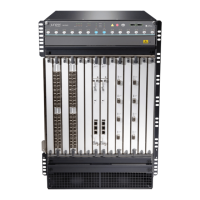The small tab on the metal housing that is controlled by the release lever must be
inside of the corresponding slot at the bottom of the power supply. This tab is used
to pull the power supply down in the chassis slot, prior to removing the power supply.
7. While firmly pushing the handle on the power supply faceplate with one hand, use
your other hand to pull the spring-loaded locking pin in the release lever away from
the chassis and turn the release lever clockwise until it stops.
8. Let go of the locking pin in the release lever. Ensure that the pin is seated inside the
corresponding hole in the chassis.
9. Remove the cover protecting the terminal studs on the faceplate.
10. Remove the nut and washer from each of the terminal studs.
11. Secure each power cable lug to the terminal studs, first with the split washer, then
with the nut. Apply between 23 in-lb. (2.6 Nm) and 25 in-lb. (2.8 Nm) of torque to
each nut. Do not overtighten the nut. (Use a 7/16-in. [11-mm] torque-controlled driver
or socket wrench.)
a. On INPUT 0, attach the positive (+) DC source power cable lug to the RTN (return)
terminal as shown in Figure 11 on page 22. Repeat this step for INPUT 1 if using two
feeds.
b. On INPUT 0 attach the negative (–) DC source power cable lug to the –48V (input)
terminal. Repeat this step for INPUT 1 if using two feeds.
CAUTION: Ensure that each power cable lug seats flush against the surface
of the terminal block as you are tightening the nuts. Ensure that each nut
is properly threaded onto the terminal stud. The nut should be able to spin
freely with your fingers when it is first placed onto the terminal stud.
Applying installation torque to the nut when improperly threaded may
result in damage to the terminal stud.
CAUTION: The maximum torque rating of the terminal studs on the DC
power supply is 36 in-lb. (4.0 Nm). The terminal studs may be damaged
if excessive torque is applied. Use only a torque-controlled driver or socket
wrench to tighten nuts on the DC power supply terminal studs.
NOTE: The DC power supplies in slots PEM0 and PEM1 must be powered
by dedicated power feeds derived from feed A, and the DC power supplies
in PEM2 and PEM3 must be powered by dedicated power feeds derived
from feed B. This configuration provides the commonly deployed A/B feed
redundancyforthe system. For information about connecting to DC power
sources, see Electrical Specifications for the MX960 DC Power Supply.
12. Verify that the power cabling is correct, that the cables are not touching, and that they
do not block access to router components or drape where people could trip on them.
23Copyright © 2015, Juniper Networks, Inc.
Connect Power to a DC Router with High-Capacity Power Supplies

